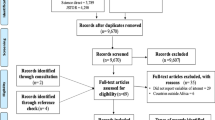Abstract
Integrated assessment (IA) can be defined as a structured process of dealing with complex issues, using knowledge from various scientific disciplines and/or stakeholders, such that integrated insights are made available to decision makers (J. Rotmans, Enviromental Modelling and Assessment 3 (1998) 155). There is a growing recognition that the participation of stakeholders is a vital element of IA. However, only little is known about methodological requirements for such participatory IA and possible insights to be gained from these approaches. This paper summarizes some of the experiences gathered in the ULYSSES project, which aims at developing procedures that are able to bridge the gap between environmental science and democratic policy making for the issue of climate change. The discussion is based on a total of 52 IA focus groups with citizens, run in six European and one US city. In these groups, different computer models were used, ranging from complex and dynamic global models to simple accounting tools. The analysis in this paper focuses on the role of the computer models. The findings suggest that the computer models were successful at conveying to participants the temporal and spatial scale of climate change, the complexity of the system and the uncertainties in our understanding of it. However, most participants felt that the computer models were less instrumental for the exploration of policy options. Furthermore, both research teams and participants agreed that despite considerable efforts, most models were not sufficiently user-friendly and transparent for being accessed in an IA focus group. With that background, some methodological conclusions are drawn about the inclusion of the computer models in the deliberation process. Furthermore, some suggestions are made about how given models should be adapted and new ones developed in order to be helpful for participatory IA.
Similar content being viewed by others
References
J. Rotmans, Environmental Modelling and Assessment 3 (1998) 155.
S.O. Funtovicz and J.R. Ravetz, Uncertainty and Quality in Science for Policy (Kluwer, Dordrecht, 1990).
F.L. Toth and E. Hizsnyik, Environmental Modelling and Assessment 3 (1998) 193.
E.A. Parson, Environmental Modelling and Assessment 2 (1997) 267.
http://www.zit.th-darmstadt.de/ulysses
J. Jäger, Environmental Modelling and Assessment 3 (1998) 143.
R.S.J. Tol, Vellinga and Pier, Environmental Modelling and Assessment 3 (1998) 181.
B. Kasemir, Behringer, Jeannette, De Marchi, Bruna, Deuker, Christoph, Dürrenberger, Gregor, Funtowicz, Silvio, Gerger, Asa, Giaoutzi, Maria, Haffner, Yvonne, Nilsson, Mans, Querol, Cristina, Schüle, Ralf, Tabara, David, van Asselt, Marjolein, Vassilarou and W. Demetra, Focus Groups in Integrated Assessment – The ULYSSES pilot Experience, Technical University of Darmstadt, ZIT Center for Interdisciplinary Studies in Technology, Darmstadt (1997).
U. Dahinden, Querol, Cristina, Jäger, Jill, Nilsson and Mans, Using computer models in participatory integrated assessment – Experiences gathered in the ULYSSES project and recommendations for further steps, ULYSSES working paper WP-99-2, Technical University of Darmstadt, Sociological Institute, Darmstadt (1999).
G. Dürrenberger, Behringer, Jeannette, Dahinden, Urs, Gerger, Asa, Kasemir, Bernd, Querol, Cristina, Schüle, Ralf, Tabara, David, Toth, Ferenc, van Asselt, Marjolein, Vassilarou, Demetra, Willi, Nicole, Jaeger and Carlo (1997), Focus Groups in Integrated Assessment. A manual for a participatory tool, ULYSSES working paperWP-97-2, Technical University of Darmstadt, ZIT Center for Interdisciplinary Studies in Technology, Darmstadt, 1997.
ULYSSES, Technical University of Darmstadt, ZIT Center for Interdisciplinary Studies in Technology, Darmstadt, 1998.
http://hdgc.epp.cmu.edu/public/icam/icam.html
http://CLEAR.eawag.ch/models/impactsE.html
C. Schlumpf, Behringer, Jeannette, Dürrenberger, Gregor, Pahl-Wostl and Claudia, Environmental Modelling and Assessment 4 (1998) 1.
http://CLEAR.eawag.ch/models/cozweiE.html
B. De Marchi, S. Funtowicz, C. Gough, A. Guimarães Pereira and E. Rota, The ULYSSES Voyage: The ULYSSES project at the JRC. EUR 17760EN (Joint Research Centre – European Commission, Ispra, 1998).
J. van der Sluijs, Jaeger and Jill, Towards a Typology for Computer Tools for participatory Integrated Assessment, Working paper, University of Utrecht, Utrecht (1998).
J. Stocks, Citizen discussions of computer models in global climate change focus groups, Working paper, Carnegie Mellon University, Pittsburgh, Pennsylvania, USA (1998).
M.G. Morgan, Smuts, Tom, Dowlatabadi, Hadi, Fischhoff, Baruch, Lave, Lester, Rubin, eds., Brochure: Global Warming and Climate Change (Carnegie Mellon University, Pittsburgh, 1994).
M. Nilsson, Computer Tool Experiences in ULYSSES (Stockholm Environment Institute, Stockholm, 1998).
D.H. Meadows, D.L. Meadows, J. Randers and W.W. Behrens, The Limits to Growth (Universe Books, New York, 1972).
J. Oakhill, Mental Models in Cognitive Science (Taylor and Francis, London, 1996).
A. Bostrom, M.G. Morgan, B. Fischhoff and D. Read, Risk Analysis 14 (1994) 959.
P.N. Johnson-Laird, Mental Models (Cambridge University Press, Cambridge, 1983).
D. Kahneman, Slovic, Paul, Tversky and Amos, Judgment under Uncertainty: Heuristics and Biases (Cambridge University Press, 1991) (first published: 1982).
G. Gigerenzer, Todd and M. Peter, Simple Heuristics that Make us Smart (Oxford University Press, New York, NY, 1999).
A. Guimaraes, Gough, Clair, De Marchi and Bruna, International Journal of Environment and Pollution (1998), accepted.
E. Darier, Schuele and Ralf, “Think Globally, Act Locally?” Climate Change and Public Participation in Manchester and Frankfurt, Local Environment (1998), submitted.
E. Darier, Gough, Clair, De Marchi, Bruna, Funtowicz, Silvio, R. Grove-White, Kitchener, Dryan, Pereira, Angela, Wynne and Brian, Between Democracy and Expertise? Citizens' Participation and Environmental Integrated Assessment in Venice (Italy) and St. Helens (UK), Journal of Environmental Policy and Planning (1998), submitted.
Author information
Authors and Affiliations
Rights and permissions
About this article
Cite this article
Dahinden, U., Querol, C., Jäger, J. et al. Exploring the use of computer models in participatory integrated assessment – experiences and recommendations for further steps. Integrated Assessment 1, 253–266 (2000). https://doi.org/10.1023/A:1018901603136
Issue Date:
DOI: https://doi.org/10.1023/A:1018901603136




